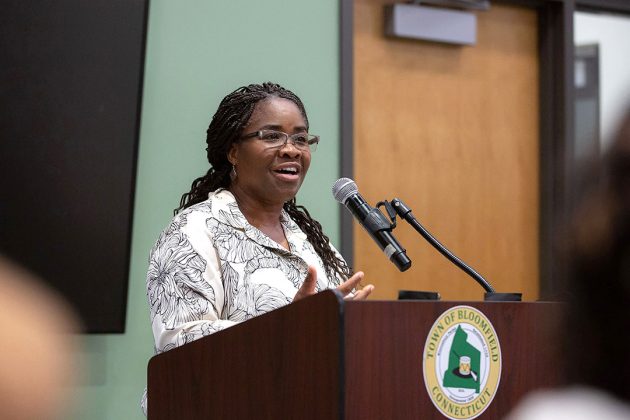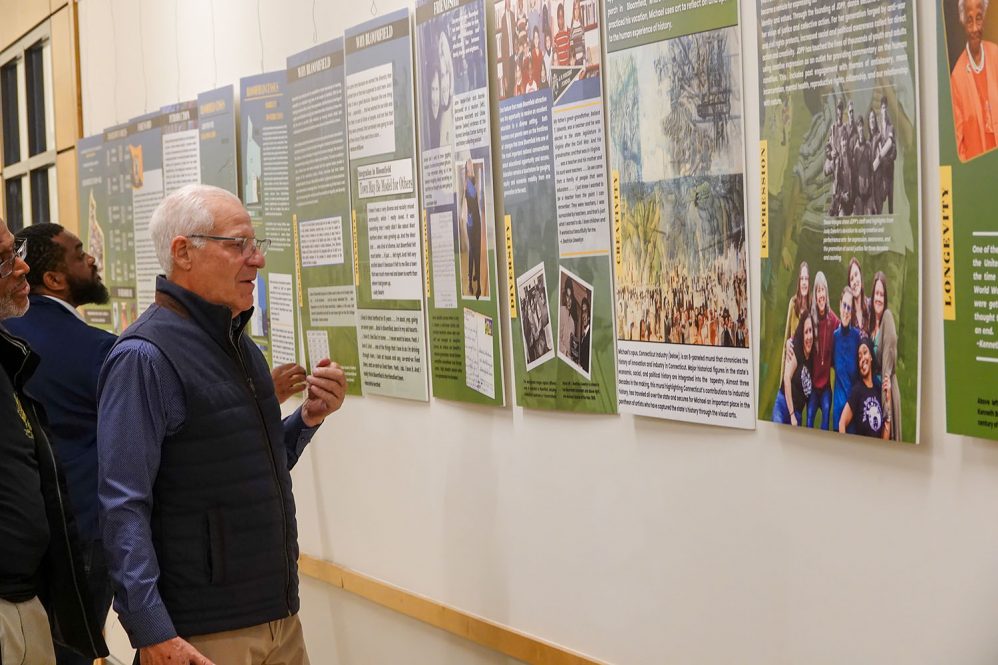As Bloomfield marks its 190th anniversary, a UConn research team is helping preserve the stories that define the town’s cultural identity, capturing the voices of residents who built their lives there in the 20th century.
On Oct. 30, residents gathered at the Alvin and Beatrice Wood Human Services Center for the opening of “Bloomfield Mosaic: Stories from our Jewish, African American, and West Indian Communities.” The exhibition was created in partnership with UConn Engaged, Public, Oral, and Community Histories (EPOCH), led by Fiona Vernal, associate professor of history and Africana studies and associate director of the Africana Studies Institute.
The exhibition features more than 40 oral histories collected by Bloomfield volunteers and UConn collaborators, highlighting the personal experiences, traditions, and community legacies that define the town. Through photographs, recorded interviews, and multimedia displays, visitors can explore the intertwined histories of the three communities that comprise the majority of Bloomfield’s population.
“It was really important that we weave those stories together into one narrative,” Vernal says. “The exhibit shows why they’re proud of their town, why they’re proud of their heritage.”
“Bloomfield Mosaic” continues Vernal’s work to preserve local history in towns across the state, following projects in Enfield, Hartford, and Windsor.
Founded by Vernal in 2015, EPOCH is a community-engaged scholarship initiative in the Department of History that supports oral history training, research, and public storytelling. The impact of the program has grown over the past decade, thanks in part to funding from the College of Liberal Arts and Sciences and a partnership grant from Connecticut Humanities.
“We provide faculty expertise and oral history training, we write the exhibition text, and we work with a professional design team,” Vernal says. “Our goal is to put UConn on the map for having the biggest oral history collection of representatives from Connecticut communities, one town at a time.”

The seeds of exhibition were planted in 2022, when members of the Bloomfield Humanities Committee attended a previous EPOCH-led exhibition, “Home Away From Home: Greater Hartford’s West Indian Diaspora,” at the Windsor Historical Society. Inspired by that project, the committee members approached Vernal about documenting Bloomfield’s evolving history and cultural diversity.
They also asked Vernal to train local volunteers to conduct the oral histories themselves, a change that deepened the community involvement, according to Donna Wnuck, a member of the Bloomfield Humanities Committee who spoke at the exhibit’s opening.
The project launched in early 2023 with about 20 volunteers, including members of the Bloomfield Humanities Committee and the Wintonbury Historical Society. Vernal led training sessions on oral history collection and interview techniques, working with Timothy Brown, a Ph.D. student in UConn’s Department of History and a research assistant with EPOCH.
“My dissertation focuses on the 19th-century antislavery movement in Connecticut, but this project looks at the consequences of that period and how communities interact with history,” Brown says. “This was an opportunity for me to be in the community, and for us to learn together about what it means to do oral histories.”
According to Vernal, the group organized scanning days, where residents contributed family photos and artifacts that were included in the collection. Volunteers also conducted long-form interviews with participants, whose stories were curated into the exhibition. Vernal’s team wrote the exhibition text and worked with professional designers to organize the collected materials.
The result of this community effort highlights Bloomfield’s role as a microcosm of Connecticut’s changing cultural landscape. Interviews with residents trace the town’s evolution as a place that embraces diversity as a core part of its identity.
From the early and mid-1900s, when Black and Jewish families found refuge here amid housing discrimination, to the mid-century arrival of West Indian immigrants seeking new opportunities, Bloomfield has long been a place of welcome and strength.
– From “Bloomfield Mosaic: Stories from our Jewish, African American, and West Indian Communities”
“It’s incredible to see this exhibition come to life, especially at a time when the work of documenting historical heritage can feel so uncertain,” Vernal says. “Projects like this show how we can sustain the work and keep it going.”
The traveling exhibition will next appear at Seabury, a Bloomfield-based senior living community, where it will be on display for residents — including several who participated in the project as interview subjects. The long-form interviews will also be archived with the Wintonbury Historical Society.
For Vernal, “Bloomfield Mosaic” is more than an exhibitionit’s an example of how research in the humanities creates real-world impact.
“This project shows what UConn is doing in the community, and how we are helping communities tell their own stories,” Vernal says.
The “Bloomfield Mosaic” opening exhibition was made possible with support from Connecticut Humanities, Seabury, and Seabury-at-Home.



